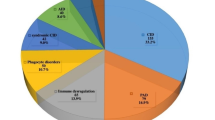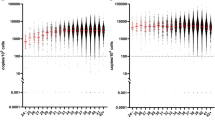Abstract
Screening and detection of clinically significant antibodies among antenatal women plays an important role in transfusion safety and preventing hemolytic disease of fetus and newborn. Routine screening of antenatal women for antibodies is not done in all blood centres of our country and so immunization rates are not known in pregnant women. We studied the prevalence of alloantibodies and titration of Anti D among antenatal multiparous women in Jammu region. In present prospective study, 750 antenatal multiparous women attending antenatal clinics were typed for ABO and D antigens. Alloantibody screening was done, if positive, specificity of alloantibody was ascertained by using commercially available red cell panel by tube method. Rate of alloimmunization was correlated with Rh D status, gravida, previous transfusion history and bad obstetric history. Titration of alloantibody D was done in first and third trimester of pregnancy. In present study most common blood group detected was B positive (38.4 %). Rh D negative cases constituted 7.6 % of total cases. Rate of alloimmunization was 2 %. A significant correlation was seen between Rh D-negative and alloimmunization (21 % in D-negative and 0.45 % in D-positive). There is significant increasing degree of alloimmunization with increase in Gravida. Alloimmunization in females with bad obstetric history was high (4.41 %) as compared to females with no bad obstetric history showing only 1.76 %. Alloantibodies detected were Anti-D, Anti-E, Anti-C and Anti-K. Anti-D constituted 80 % of all alloantibodies detected. Six women in their third trimester had raised titers of anti-D. Most common alloantibody detected was anti-D (80 %). Alloantibodies to other Rh antigens and Kell blood group systems were also identified. To minimize alloimmunization in Rh D negative women, proper Anti D immunoprophylaxis should be implemented.
Similar content being viewed by others
References
Judd WJ, Luban NLC, Ness PM, Silberstein, Stroup M, Widmann FK (1990) Prenatal and perinatal immunohematology: recommendations for serological management of the fetus, newborn, infant and obsteric patients. Transfusion 30(2):175–183
British Committee for standards in Haematology (2008) Guidelines for blood grouping and red cell antibody testing during pregnancy
Semmekrot BA, de Man AJ, Boekkooi PF (1999) Irregular blood group antibodies during pregnancy: screening is mandatory. Ned TijdschrGeneeskd 143:449–452
Saran RK (2003) Transfusion medicine, technical manual, Sponsored by WHO and published by Director General Health Services
Drugs and Cosmetics Act (1989) The Gazette of India, Government of India. New Delhi
Pahuja S, Gupta SK, Pujani M, Jain M (2011) The prevalence of irregular erythrocyte antibodies among antenatal women in Delhi. Blood Transfus 9(4):388–393
Varghese J, Mary P, Chacko Rajaiah M, Daniel D (2013) Red cell alloimmunization among antenatal women attending a tertiary care hospital in south India. Indian J Res 138:68–71
Koelewijn JM, Vrijkotte TG, Van der Schoot C (2008) Effect of screening for red cell antibodies, other than anti-D, to detect hemolytic disease of the fetus and newborn: a population study in the Netherlands. Transfusion 48:941–952
Al-Ibrahim NA, Al Saeed AH (2008) Red blood cell alloimmunization among Saudi pregnant women in the central province of Saudi Arabia. Kuwait Med J 40:116–123
Gottvall T, Filbey D (2008) Alloimmunization in pregnancy during the years 1992–2005 in the central west region of Sweden. Acta Obstet Gynecol 87:843–848
Lurie S, Eliezer E, Piper I, Woliovitch I (2003) Is antibody screening in Rh(D)-positive pregnant women necessary? J Mater Fetal Neonatal Med 14:404–406
Lee CK, Ma ESK, Tang M, Lam CC, Lin CK, Chan LC (2003) Prevalence and specificity of clinically significant red cell alloantibodies in Chinese women during pregnancy: a review of cases from 1997 to 2001. Transfus Med 13:227–231
Chandrasekar A, Morris KG, Tubman TR, Tharma S, McClelland WM (2001) The clinical outcome of non-Rh(D) antibody affected pregnancies in Northern Ireland. Ulster Med J 70(2):89–94
De Vrijer B, Harthoorn-Lasthuizen EJ, Oosterbaan HP (1999) The incidence of irregular antibodies in pregnancy: a prospective study in the region of the s-Hertogenbosch. Ned Tijdschr Geneeskd 143:2523–2527
Howarda H, Martlewa V, McFadyen I, Clarke C, Duguid J, Bromilow I, Eggington J (1998) Consequences for fetus and neonate of maternal red cell allo-immunisation. Arch Dis Child Fetal Neonatal Ed 78:F62–F66
Filbey D, Hanson U, Wesstrom G (1995) The prevalence of red cell antibodies in pregnancy correlated to the outcome of the newborn: a 12 year study in Central Sweden. Acta Obstet Gynecol Scand 74:687–692
Salola A, Sibai B, Mason JM (1983) Irregular antibodies: an assessment of routine prenatal screening. Obstet Gynaecol 61:25–30
Mollison PL, Engelfnet CP, Contreras M (1997) Blood transfusion in clinical medicine, 10th edn. Blackwell Scientific Publications, Oxford
Hadley AG (1998) In vitro a comparison of tests for predicting the severity of haemolytic disease of the foetus and newborn. Vox Sang 74:375–383
Daniels G (1995) Human blood Groups. Blackwell Science, Oxford
Rahman MM, Mondal AG, Islam MA et al (2011) Study on detection of Rhesus-D Antibody and Titer of Chittagong Division Dinajpur. Med Col J 4(2):80–82
Harmening DM (2008) Modern blood banking and transfusion practices, 5th edn. Jaypee Brothers, New Delhi, pp 387–389
Author information
Authors and Affiliations
Corresponding author
Rights and permissions
About this article
Cite this article
Sidhu, M., Bala, R., Akhtar, N. et al. Prevalence, Specificity and Titration of Red Cell Alloantibodies in Multiparous Antenatal Females at a Tertiary Care Centre from North India. Indian J Hematol Blood Transfus 32, 307–311 (2016). https://doi.org/10.1007/s12288-015-0593-3
Received:
Accepted:
Published:
Issue Date:
DOI: https://doi.org/10.1007/s12288-015-0593-3




